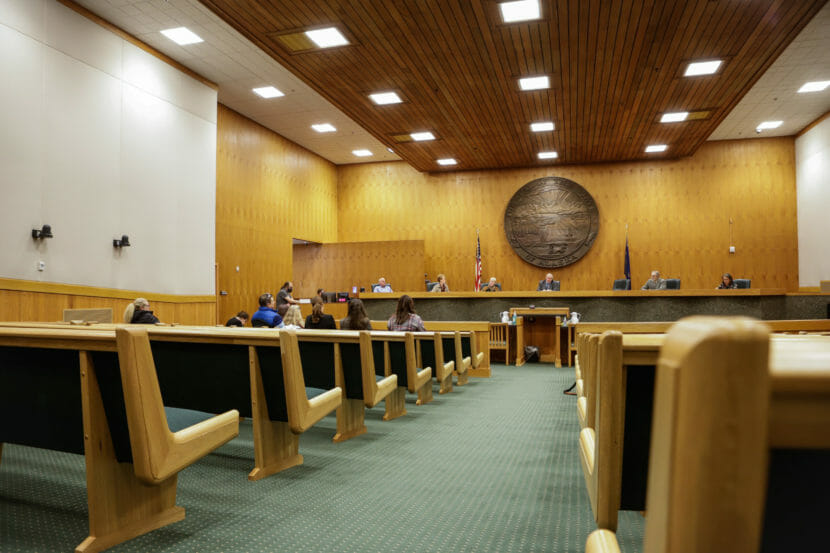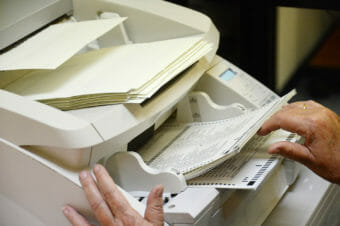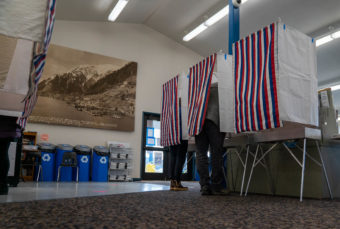
Most Alaskan voters, like Teresa Cortes of South Anchorage, weigh in on judicial retention votes.
“Oh yeah, I don’t know any of the judges,” she said. “So normally, I vote yes on all of them — unless there’s one that stands out that I, you know, heard bad things from. Then I don’t vote.”
But election results over several decades show a growing minority of Alaskans vote like Richard “Ziggy” Zeigler of downtown Anchorage.
“Oh, I voted no for every one of them,” he said. “Why? Because I like fresh blood and because I think we do need turnover when it comes to judges.”
He said he thinks judges burn out and lose their compassion over time — though he didn’t read up on any of the judges he voted to fire.
“Do you know how many judges were on the back of that damn thing?” he said of this year’s ballot, which listed 20 judges for most Alaskans. “For me to try to do the research on each one would have been a pain in the ass.”
Unofficial results from this year’s election show all 29 of the Alaska judges up for retention secured another term, ranging from four to eight years. That’s pretty normal. Only six judges have ever lost a retention election in the entire history of the state.
But judges in Alaska’s population-heavy Third Judicial District, where Zeigler and most other Alaskans live, are being retained by the narrowest margins in the state, in a state with the lowest margins in the nation.
This year, state judges’ median approval rating is going to hit a record low. Nineteen of them will be retained with less than 60% percent of the vote. The trend suggests lots of qualified judges could be ousted in future elections, creating huge headaches in the justice system.
Political campaigns, pollsters and the media tend to focus on the races at the top of the ballot, so it’s hard to nail down why more and more Alaskans are voting to fire judges.
“It’s a very uniquely Alaskan thing,” said statistician and researcher Albert Klumpp, who lives in Chicago but studies and tracks judicial retention elections nationwide. “And it seems to be more of an anti-system vote, than anything to do with the judges themselves.”
Alaska is unlike other states
The judges this year, and in years past with few exceptions, got positive professional evaluations and recommendations from the Alaska Judicial Council. The nonpartisan council recommended retaining all of the judges on the ballot this year.
And none of the judges this year notified the Alaska Commission on Judicial Conduct that they were being actively opposed, according to its Executive Director Marla Greenstein. If they were, then they’d be allowed to campaign for their own retention.
Klumpp got interested in researching Alaska several years ago because there was concern in the legal community, especially in Anchorage.
“Rates had been dropping over time and were approaching a level where it might be possible that an entire slate of judges could be wiped off the ballot by just a blanket no vote from enough people,” he said.
These judges make life-altering decisions on everything from crime and punishment to child custody, to mundane traffic violations and property disputes.
Klumpp’s research, including a 2017 article in the Alaska Law Review, makes it easy to compare Alaska to other states. Alaska doesn’t track with other politically conservative states, which tend to have the highest approval ratings for their judges. He said South Dakota, Utah, Wyoming and Montana have some of the highest judicial approval ratings in the nation.
“Those are not places that are, you know, teeming with social justice warriors — those are very staunchly conservative places,” he said. “And yet they support their judges at very high rates. Even more than some more balanced or Democratic states.”
One thing that does stick out to Klumpp in Alaska is the push to rewrite the state constitution so Alaskans have a more direct role in picking judges. He thinks that campaign, partially embodied by the constitutional convention question this year, may have driven more people to vote against retaining judges than normal.
Political preferences and geography
Some justice system experts speculate that differences in Alaskans’ political preferences over time and geography are behind the voting patterns.
The Third Judicial District, where judges are being retained by the narrowest margins, includes Anchorage, Mat-Su, the Kenai Peninsula, Kodiak, Bristol Bay and the Aleutians. Population-wise, it’s bigger than the other three judicial districts combined, which is why it has so many more judges, and the ballots are so long.
Unlike legislative districts, judicial districts don’t get redrawn to match population shifts. Alaska’s appear to be a vestige of federal census districts from well before statehood. In the last 100-plus years, officials haven’t added any districts, or dramatically changed the existing districts’ lines.
Southcentral is more conservative than the rest of the state, and some social conservatives malign Alaska’s judicial selection and retention system. They want the average voter and elected officials to have a more direct role in picking judges, while the authors of the state constitution wanted to shield judges from politics and focus on professional merit.
This year, Jim Minnery, the head of the Alaska Family Council, urged Alaskans to vote against retaining all of the judges. Minnery couldn’t be reached for comment. But he’s written that he thinks the judiciary doesn’t reflect the state’s conservative lean.
What if Minnery got his way and a whole slate of judges were fired at the same time?
“Well, I think it would wreak havoc in the system,” said former Alaska Attorney General Michael Gergaghty.
Geraghty served during Republican Gov. Sean Parnell’s administration, and he wrote a column in the Anchorage Daily News before the election about judicial retention. He called blindly voting no on all judges “extreme” and urged voters to at least make informed decisions.
Contrary to what some voters said, it’s easy to read up on judges. The state Division of Elections distributes summaries of professional evaluations of judges in voter information pamphlets. The evaluations are also published online.
Susanne DiPietro is the executive director of the Alaska Judicial Council, which vets potential judges and sends a short list to the governor for appointments. DiPietro said the council’s process is thorough and detailed, and not set up for handling many potential judges for dozens of openings at the same time.
“It would just be extremely difficult. I mean, really impossible for the council to replace large numbers of judges quickly,” DiPietro said. “A scenario like that certainly was not contemplated by the founders.”
A shortage of judges would undermine a criminal defendant’s right to a speedy trial and the timeliness of any litigation.
“I hope it never comes to that,” Geraghty said. “It would be a very serious disruption to our system if judges started getting voted out like that.”
More people in smaller communities vote yes
DiPietro does have an apolitical theory about the geographic disparity in the voting patterns, that voters in the Third Judicial District are just a lot less likely to have a personal connection to the judges on their ballots.
“I have wondered if that could be a dynamic that happens in the smaller communities, where people are just closer to the courts and to the judges in the community, and they know the judges as people,” she said.
That contrast was on display during a public hearing the judicial council held at a courthouse in downtown Anchorage recently about applicants for two openings on the Anchorage Superior Court.
The courtroom was nearly empty. Alaska Supreme Court Justice Daniel Winfree, who presides over the council, thanked the few people who participated.
“We appreciate it. It’s always nice to hear people come in and chat – particularly in Anchorage, where it doesn’t happen all the time,” he said.
DiPietro said in smaller communities, the public packs the room for these types of hearings.



